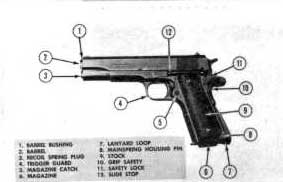|
|
|
Arms of WWII |
||||||||||||||||||||||||||||||||||||||||||
|
Major American Firearms Manufacturers of the Second World War |
||||||||||||||||||||||||||||||||||||||||||
|
|
M1
Garand Rifle |
|
|
US Rifle, Cal. .30, M1 |
|
|
|
|
|
|
|
|
The
weapon Captain Green used to halt Kampfgruppe Peiper was the M1 carbine,
a lighter version of the M1, the standard infantry rifle of the US Army.
This was an excellent weapon, modern in design and very reliable. It was
the first semi-automatic rifle in general use by a major power.
|
|
|
M1/M1928
Thompson |
|
| M1921/1928/1928A1
Thompson -
The
Thompson submachine gun is one of the most famous, most recognized
guns in the world. First designed and made in an era when cheap labor
enabled lavish expenditures of time and materials, the Thompson was an
over-engineered, bulky, heavy gun. The Thompson answered a question
that had not been asked yet: What kind of gun is needed for mobile
troops on a rapidly changing battlefield? For mounted troops? For
urban warfare? For paratroops? When World War II came along and
"asked" these questions the Thompson was the only answer.
Auto-Ordnance had still not sold all of the original production run of
1921. It was a beautiful gun. It was reliable. It did not wear out.
And it fired the biggest pistol cartridge anyone had - the .45 CAP.
But the realities of war overcame this wonderful gun. The Thompson
took too long to make, and was too expensive to make. Production was
simplified, and finally in mid-war the production of the Thompson
ceased in favor of the M3 Grease gun. To say that the pendulum swung
the other way would be an understatement. Later advancements in gun
and ammunition design eliminated the need for a submachine gun. The
Thompson remains one of the unique American icons. In its glory days
of W.W.II it provided un-equaled close range firepower to American and
Allied troops. It served on through Korea and Vietnam. Nobody is
sorry they carried one. This gun is hugely popular due to its use in
Korea and Vietnam, frequent use in gangster and war movies, and due to
the "revival" of interest in World War II.
|
|
|
M1911 Pistol |
|
|
|
 |
|
Automatic Pistol, Caliber .45, M1911A1 |
|